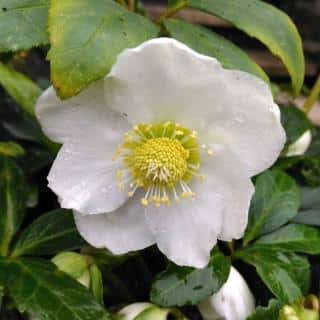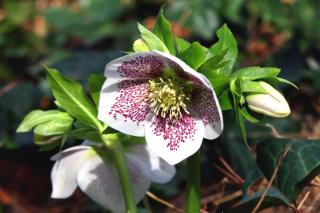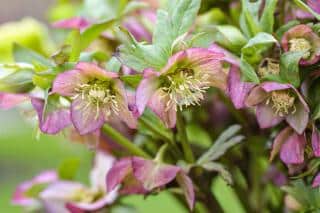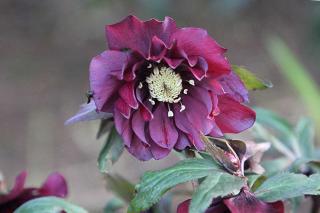

Lenten rose is the hellebore that’s most planted in our gardens. Its appeal lies in its abundant and long-lasting blooming.
Helleborus orientalis key facts
Botanical name – H. orientalis
Common name – Hellebore of the Orient, Lenten rose
Family – Ranunculaceae
Type – perennial herbaceous flower
Height – 12 to 30 inches (30 to 80 cm)
Exposure – shade to part shade
Soil – rich, cool, well-draining
Planting: spring, end of summer – Flowering: end of winter, spring
The Lenten hellebore is a perennial that belongs to the Ranunculaceae family. It comes from the Caucasian mountains, Turkey and Greece, originally. Today, it’s the variety that most often appears in our gardens: it bears simple or double flowers, even triple flowers sometimes. The range of possible colors is amazing and depends on the cultivar you choose to plant. Indeed, you can find Helleborus orientalis that display flowers in white, yellow, red, orange, black and even spotted, dotted striped and mottled ones.
 The Lenten rose is a tall-growing species: in time, it can reach a height of 2½ feet (80 cm) and a spread of 5 feet (150 cm). This evergreen plant has basal leaves that are palmate and lightly serrated around the edges. They’re leathery and, when clean, are a shiny deep green color. From the center of this abundant leafage, tall floral scapes with many branches emerge. On each branch, anywhere from one to four flowers will appear, usually facing downwards. Each flower can last 5 to 8 weeks, a record in terms of longevity.
The Lenten rose is a tall-growing species: in time, it can reach a height of 2½ feet (80 cm) and a spread of 5 feet (150 cm). This evergreen plant has basal leaves that are palmate and lightly serrated around the edges. They’re leathery and, when clean, are a shiny deep green color. From the center of this abundant leafage, tall floral scapes with many branches emerge. On each branch, anywhere from one to four flowers will appear, usually facing downwards. Each flower can last 5 to 8 weeks, a record in terms of longevity.
Be careful – this is an extremely poisonous plant that should only be handled with gloves.
 There is a number of different Lenten rose cultivars. Indeed, the many hellebore hybrids that are now on the market have this species as a parent.
There is a number of different Lenten rose cultivars. Indeed, the many hellebore hybrids that are now on the market have this species as a parent.
 The oriental hellebore is a very hardy plant, it can survive temperatures even colder than 5°F (-15°C) as long as it’s planted in a place that’s sheltered from cold winds. This flower-bearing herbaceous plant is easy to grow, and as a rule it prefers shade or part shade, and rich, cool, and well-draining soil. This species offers a much better resistance to lack of water than the famous Christmas rose. It’s also quite adept at avoiding snails and aphids. The Lenten rose can serve for cut flower bouquets, and in landscaping it’s generally reserved for flower beds, along edges, and even in planters.
The oriental hellebore is a very hardy plant, it can survive temperatures even colder than 5°F (-15°C) as long as it’s planted in a place that’s sheltered from cold winds. This flower-bearing herbaceous plant is easy to grow, and as a rule it prefers shade or part shade, and rich, cool, and well-draining soil. This species offers a much better resistance to lack of water than the famous Christmas rose. It’s also quite adept at avoiding snails and aphids. The Lenten rose can serve for cut flower bouquets, and in landscaping it’s generally reserved for flower beds, along edges, and even in planters.
 Just before the blooming, which should appear between February and April, make sure to remove old and damaged leaves. This will highlight the beauty of the lenten rose’s flowers.
Just before the blooming, which should appear between February and April, make sure to remove old and damaged leaves. This will highlight the beauty of the lenten rose’s flowers.
Upon planting, enrich the soil with ripe compost, mixing it in well with the soil in the hole. The goal of this well-fertilized soil is to allow for fabulous blooming. In spring, pour a little additional fertilizer around them, and in fall, spread a layer of fresh, rich soil mix at the base of your Lenten roses.
Lastly, sometime between October and November, layer organic mulch at the foot of your hellebores so that the roots may be protected from the worse of the winter cold.
The lenten rose tends to sow itself naturally around the garden. Seeds fall to the ground in June, and after about 6 months they start germinating. However, these natural seedlings rarely match the mother plant. They might interfere with the layout in carefully planned-out colored flower beds. If this is something that hassles you, cut wilted flowers in May to block seed formation: no more self-sown seedlings!
In the end, the best way to propagate lenten rose is to divide it. This method also triggers more vigorous regrowth. Divide your Lenten rose clumps in spring, just when the blooming is over.
To learn more, read: